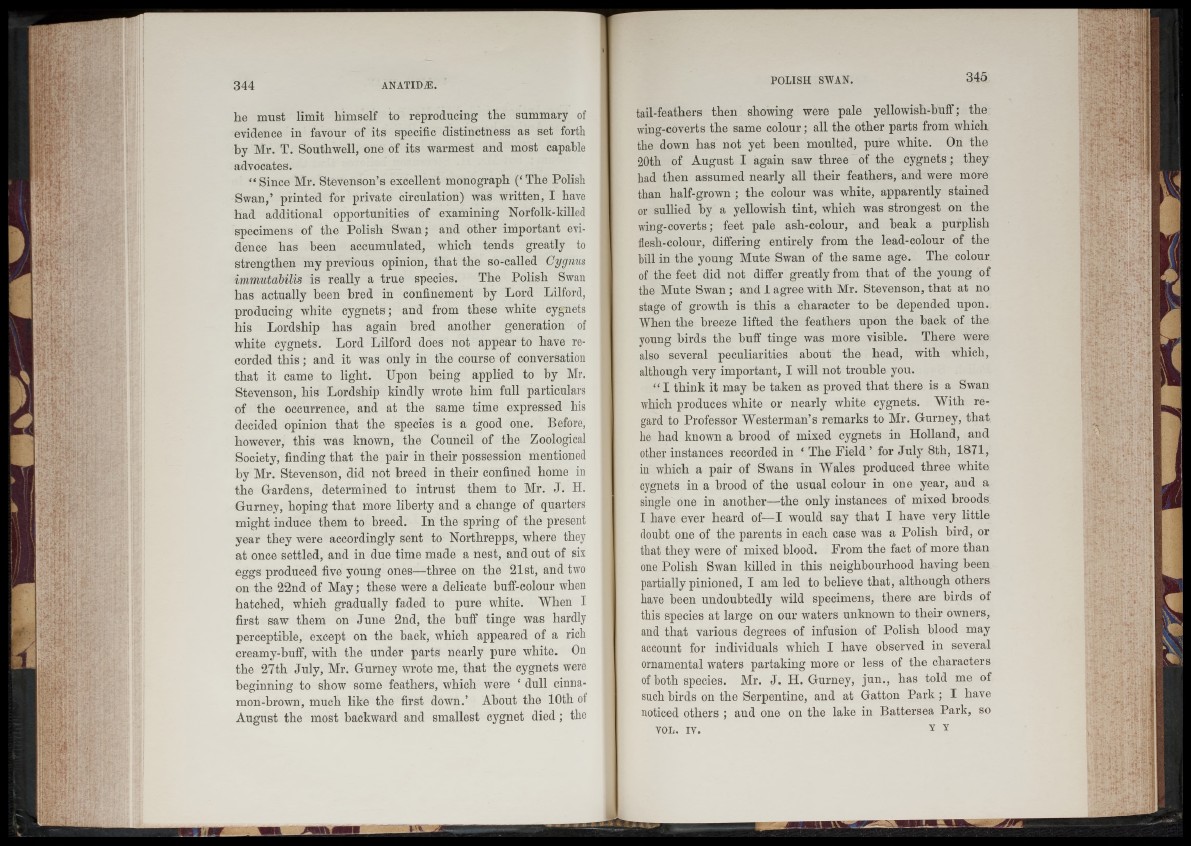
he must limit himself to reproducing the summary of
evidence in favour of its specific distinctness as set forth
by Mr. T. Southwell, one of its warmest and most capable
advocates.
“ Since Mr. Stevenson’s excellent monograph (‘The Polish
Swan,’ printed for private circulation) was written, I have
had additional opportunities of examining Norfolk-killed
specimens of the Polish Swan; and other important evidence
has been accumulated, which tends greatly to
strengthen my previous opinion, that the so-called Cygnus
immutabilis is really a true species. The Polish Swan
has actually been bred in confinement by Lord Lilford,
producing white cygnets; and from these white cygnets
his Lordship has again bred another generation of
white cygnets. Lord Lilford does not appear to have recorded
th is; and it was only in the course of conversation
that it came to light. Upon being applied to by Mr.
Stevenson, his Lordship kindly wrote him full particulars
of the occurrence, and at the same time expressed his
decided opinion that the species is a good one. Before,
however, this was known, the Council of the Zoological
Society, finding that the pair in their possession mentioned
by Mr. Stevenson, did not breed in their confined home in
the Cardens, determined to intrust them to Mr. J. H.
Gurney, hoping that more liberty and a change of quarters
might induce them to breed. In the spring of the present
year they were accordingly sent to Northrepps, where they
at once settled, and in due time made a nest, and out of six
eggs produced five young ones—three on the 21st, and two
on the 22nd of May; these were a delicate huff-colour when
hatched, which gradually faded to pure white. When I
first saw them on June 2nd, the buff tinge was hardly
perceptible, except on the back, which appeared of a rich
creamy-buff, with the under parts nearly pure white. On
the 27tli July, Mr. Gurney wrote me, that the cygnets were
beginning to show some feathers, which were ‘ dull cinnamon
brown, much like the first down.’ About the lOtli of
August the most backward and smallest cygnet died; the
tail-feathers then showing were pale yellowish-buff; the
wing-coverts the same colour; all the other parts from which
the down has not yet been moulted, pure white. On the
20th of August I again saw three of the cygnets; they
had then assumed nearly all their feathers, and were more
than half-grown ; the colour was white, apparently stained
or sullied by a yellowish tint, which was strongest on the
wing-coverts; feet pale asli-colour, and beak a purplish
flesh-colour, differing entirely from the lead-colour of the
bill in the young Mute Swan of the same age. The colour
of the feet did not differ greatly from that of the young of
the Mute Swan ; and I agree with Mr. Stevenson, that at no
stage of growth is this a character to be depended upon.
When the breeze lifted the feathers upon the hack of the
young hii’ds the huff tinge was more visible. There were
also several peculiarities about the head, with which,
although very important, I will not trouble you.
“ I think it may he taken as proved that there is a Swan
which produces white or nearly white cygnets. With regard
to Professor Westerman’s remarks to Mr. Gurney, that
lie had known a brood of mixed cygnets in Holland, and
other instances recorded in ‘ The Field ’ for July 8th, 1871,
in which a pair of Swans in Wales produced three white
cygnets in a brood of the usual colour in one year, and a
single one in another—the only instances of mixed broods
I have ever heard of-—I would say that I have very little
doubt one of the parents in each case was a Polish bird, or
that they were of mixed blood. From the fact of more than
one Polish Swan killed in this neighbourhood having been
partially pinioned, I am led to believe that, although others
have been undoubtedly wild specimens, there are birds of
this species at large on our waters unknown to their owners,
and that various degrees of infusion of Polish blood may
account for individuals which I have observed in several
ornamental waters partaking more or less of the characters
of both species. Mr. J. H. Gurney, jun., has told me of
such birds on the Serpentine, and at Gatton Park ; I have
noticed others ; and one on the lake in Battersea Park, so